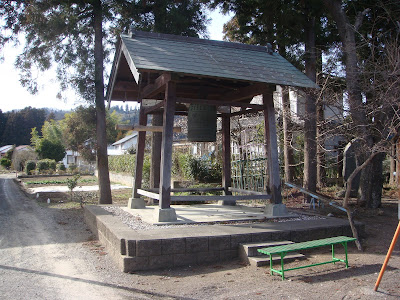Shortly after leaving the five-corner shrine behinds us, we crossed a small river.
 Considering that our current pilgrimage is to temples that have statues of Kannon, the bridge over the river was very appropriately named - Kannon Bridge.
Considering that our current pilgrimage is to temples that have statues of Kannon, the bridge over the river was very appropriately named - Kannon Bridge. On the bank on the far side of the river, we discovered a stele saying that there was a Kannon in the area. The open space behind the column is typical of shrines, temples, community centers, and schools. We took a closer look at the stele and on the back we found a reference to Temple #3 of the Oushuu33Kannon pilgrimage. However, from where we were standing the building the building did not look like a temple, but off to the left there was a bell tower, normally found on temple grounds.
On the bank on the far side of the river, we discovered a stele saying that there was a Kannon in the area. The open space behind the column is typical of shrines, temples, community centers, and schools. We took a closer look at the stele and on the back we found a reference to Temple #3 of the Oushuu33Kannon pilgrimage. However, from where we were standing the building the building did not look like a temple, but off to the left there was a bell tower, normally found on temple grounds.
We crossed the open area and found that the building really was a Shinto shrine. What in the world did this shrine have to do with Kannon, who is definitely Buddhist. We decided to explore a little more.

The building on the left was a Buddhist-style bell tower, so that just confused things even more.

We went back over to the shrine and looked carefully at the picture hanging under the eaves on the left wall. It was a surprisingly well done picture of a herd of horses being led by a man. Again horses are usually a Shinto theme, referring back to the old warrior cults of Japan.
 The only other buildings in the compound turned out to belong to the neighborhood association and yielded no information relating to Temple #3. There was no one in the area to ask so we finally left no wiser than when we first found the stele.
The only other buildings in the compound turned out to belong to the neighborhood association and yielded no information relating to Temple #3. There was no one in the area to ask so we finally left no wiser than when we first found the stele.The road paralleled the base of the hills and was bordered by farms. This picture is typical of what we saw as we walked. The fields in the foreground will be flooded and plowed soon, and then when it is warmer the rice seedlings will be planted. The type of rice that is grown in this region is called koshihikari and it is one of the tastiest of the varieties grown in Japan. We were very surprised when we moved to Sendai from Shizuoka Prefecture, even the cheapest prepared rice dishes in the supermarkets had rice that was better than 'good' rice in Shizuoka.


No comments:
Post a Comment